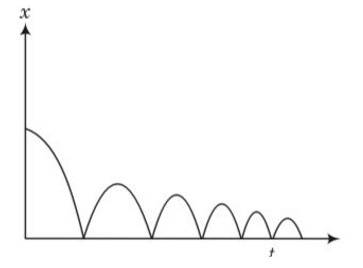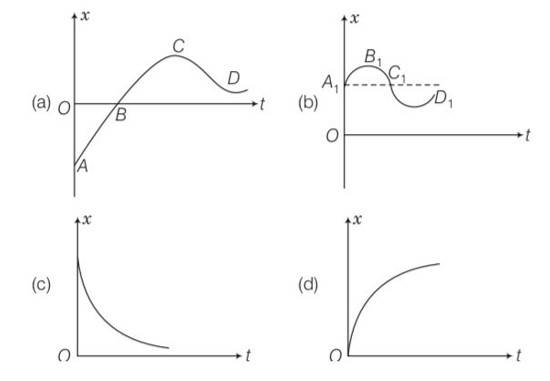Motion in a Straight Line
Get insights from 82 questions on Motion in a Straight Line, answered by students, alumni, and experts. You may also ask and answer any question you like about Motion in a Straight Line
Follow Ask QuestionQuestions
Discussions
Active Users
Followers
New answer posted
5 months agoContributor-Level 10
This is a short answer type question as classified in NCERT Exemplar
When the ball dropped from the building u1=0, u2=40m/s
Velocity of the dropped ball after time t
V1=u1+gt
V1 = gt
For ball thrown up u2=40m/s
Velocity of the ball after time t
V2=u2-gt
=40-gt
Relative velocity =v1-v2
=gt- [-40-gt]=40m/s
New answer posted
5 months agoContributor-Level 10
This is a short answer type question as classified in NCERT Exemplar
speed of first car = 18km/h
Speed of second car = 27km/hr relative with respect to each other is 18+27=45km/h
Distance between cars = 36km
Time = 36/45=0.8h
Distance covered by bird = 36 (0.8)=28.8km
New answer posted
5 months agoContributor-Level 10
This is a short answer type question as classified in NCERT Exemplar
(a) x (t)=x0 (1- )
V (t)=dx/dt= x (t)=x0 ( )
A (t)= x ( t)=x0 ( )
(b) when t=o x (t)= x (t)=x0 (1- )= x (t)=x0 (1-1)=0
x (t) is maximum when t=
x (t) is maximum when t=
v (t) is maximum when t= , v (0)=x0
v (t) is maximum when t= v ( )=0
a (t) is maximum when t= , a ( )=0
a (t) is maximum when t= , a ( )=-x0 2
New answer posted
5 months agoContributor-Level 10
This is a short answer type question as classified in NCERT Exemplar
It is clear from the graph that displacement x is positive throughout . ball is dropped from height and its velocity increases in downward direction due to gravity pull. In this condition v isnegative but acceleration of the ball equal to acceleration due to gravity.
velocity time graph
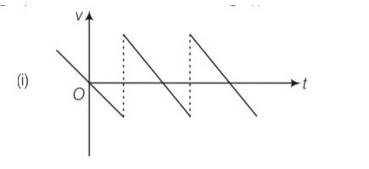
Acceleration time graph
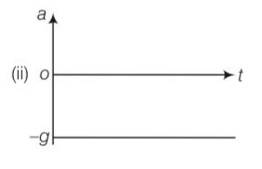
New answer posted
5 months agoContributor-Level 10
This is a short answer type question as classified in NCERT Exemplar
When speed becomes constant then acceleration will be zero
a=dv/dt=0
But here a=g-bv
Clearly from above equation as speed increases acceleration will decrease . at a certain speed say vo, acceleration will be zero and speed will remain constant.
Hence So g=bv
so v= g/b
New answer posted
5 months agoContributor-Level 10
This is a short answer type question as classified in NCERT Exemplar
x (t)=A+B
Let A>B and
Now velocity is equal to x (t)=dx/dt=-B
So a (t)= dv/dt= B
Above condition are satisfied by the equation.
New answer posted
5 months agoContributor-Level 10
This is a short answer type question as classified in NCERT Exemplar
(a) The equation we use here is x= 1-sint
So velocity = dx/dt=1-cost
Acceleration =sint
When t=o x=o
When t=, x=
When t=0.x= 2
(b) x=sint so velocity becomes v=cost as displacement and velocity contain sin and cos so equation is periodic.
New answer posted
5 months agoContributor-Level 10
This is a short answer type question as classified in NCERT Exemplar
If effect of gravity is neglected then ball moving uniformly turned back with same speed when a ball hit it. Acceleration of the ball is zero just before it hits the bat and due to the repulsive force it gets accelerated.
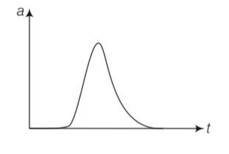
New answer posted
5 months agoContributor-Level 10
This is a short answer type question as classified in NCERT Exemplar
We have to analyse slope of each curve i.e= dx/dt . for peak values dx/dt will be zero as x is maximum at peak points.
For graph (a) there is appoint for which displacement is zero so a matches with (iii)
In graph b, x is positive throughout and at point B, V=dx/dt=0
Since at point of curvature changes a=0, so b matches with (ii)
displacement is zero in only first graph so it matches with the (iii) point.
And slope of d graph v=dx/dt is positive so v>0 so acceleration will be negative so matches with I but in graph c it matches with iv as its slope is negative.
New question posted
5 months agoTaking an Exam? Selecting a College?
Get authentic answers from experts, students and alumni that you won't find anywhere else
Sign Up on ShikshaOn Shiksha, get access to
- 66k Colleges
- 1.2k Exams
- 680k Reviews
- 1800k Answers

